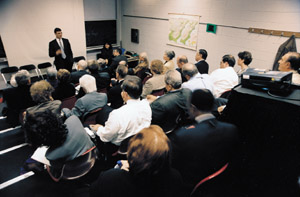Chicago:
Campus of the Big Ideas
>> The
launch of The Chicago Initiative-the University's five-year, $2
billion fund-raising effort-was marked by an April 12 event that
focused on Chicago's intellectual initiatives.
|
3
|
Integrating
the physical and biological sciences: what lies ahead? |
One
is immutable and one is evolving. One is largely theoretical,
the other often observational. One is hard and pristine, the other
tends to the soft and sticky.
Yet
scholars from the physical and the biological sciences met to
talk about how their fields, once quite distinct, have begun to
blur-and why that's a good thing.
|
|
|
Milan
Mrksich explains new ways to study cell surfaces.
|
The
session grew out of two campus projects, one small and one huge.
The small project was an effort by plant geneticist Daphne Preuss,
professor in molecular genetics & cell biology, to understand
pollen's elective affinities. Why, she wondered, does a grain
of pollen stick to the slippery female parts of one flower yet
slide right off another? Each plant's pollen, she found, carries
tiny surface markers, like molecular Velcro, that let them latch
on when they land on a related species but lack sticking power
with nonrelatives.
How
the markers work is an interesting question, but not one the tools
of biology equipped her to answer. So Preuss brought in David
Grier, an associate professor in physics, to measure the strength
of the tiny attachments, which turned out to be more powerful
than any glue, and Milan Mrksich, an associate professor in chemistry,
to isolate and purify the markers.
Such
teamwork underlies a much more massive endeavor. Now in the planning
stages, the Interdivisional Research Building will be the largest
research facility in the University's history, and at its center
will be the Institute for Biophysical Dynamics, a haven for division-crossing
projects.
Although
biology has shifted its central focus to smaller and smaller objects-from
organisms to tissues to cells to proteins and genes-by physical
science standards, these substances are still comparatively large.
Physicists have spent decades perfecting ways to manipulate far
smaller molecules and single atoms.
For
example, Grier makes optical traps-precisely focused, minute beams
of light that he uses like chopsticks to capture and move particles
measured in nanometers. He has used the traps to measure, among
other things, the elasticity of DNA. Meanwhile, Milan Mrksich
borrows techniques from the semiconductor industry to develop
tools that assess cell-surface proteins and even carbohydrates,
such as those on pollen. The protein and carbohydrate arrays can
be used to identify molecules that control cell migration, which
is useful for wound repair-and also responsible for the spread
of cancers.
Applying
chemistry and physics to biological problems is not only, as Grier
joked, a "back door to a more lucrative area." Collaboration
lets both divisions move forward at an unprecedented pace, with
results likely to have medical and scientific payoffs. Biologists
can go after once inaccessible, fundamental problems. And physical
scientists, accustomed to dealing with theoretical problems and
immutable laws, can study moving targets-or, as Grier put it,
they can "dive into systems that are highly evolved, evolving,
and evolvable."
Where
will such efforts lead? "We simply don't know," warned
Eugene Goldwasser, SB'43, PhD'50, the Alice Hogge & Arthur
A. Baer professor emeritus in biochemisty & molecular biology.
He's experienced in imprecise predictions: soon after World War
II he set out to isolate erythropoietin, the hormone that prompts
red-blood cell production. He thought it would take a few months;
it took 25 years. He then collaborated with someone equally unable
to predict the future: a University administrator who never acted
on Goldwasser's request to patent his discovery. Sales of erythropoietin
now exceed $2 billion each year.
-J.E.
1.
In
the beginning: what do our origins tell us about ourselves?
2.
Homo sapiens: are
we really rational creatures?
3.
Integrating the
physical and biological sciences: what lies ahead?
4.
Money,
services, or laws: how do we improve lives?
5.
Clones, genes, and
stem cells: can we find the path to the greatest good?
6.
How will technology change
the way we work and live?
7.
Why do we dig up
the past?
8.
Art for art's sake?
9.
In the realm of
the senses: how do we understand what we see, hear, feel, smell,
and taste?
10.
Can we protect
civil liberties in wartime?
CHICAGO
INITIATIVE GOALS


![]()
